7 July 2021 In Adaptation, Blog Post, Climate Change, Dialogue and Networking, Global, Knowledge and Policy Analysis, Mitigation, Sustainable Development
An Urgent Call for Radical Transport Climate Action to Accelerate Implementation of Sustainable
Development Goal 13
The transport sector has an immense impact on our planet’s climate, and as the fastest-growing source of global emissions, the decisions that we make today about how we move people and goods (and when it is not necessary to move them at all!), are critical to the implementation of the 2030 Agenda and the achievement of the goals of the Paris Agreement. Transport should be central to conversations at the upcoming UN High-Level Political Forum on Sustainable Development (HLPF) (6-15 July 2021) and its review of progress made towards Sustainable Development Goal (SDG) 13 on Climate Action and beyond.
Enabling sustainable, low carbon transport and mobility worldwide has explicit as well as implicit implications for the success of the entire 2030 Agenda, with important social, environmental, and economic “multiplier effects”. Some areas where transport has the greatest positive impacts include:
- Ending poverty (SDG 1);
- Ending hunger (SDG 2);
- Promoting healthy lifestyles and well-being (SDG 3);
- Empowering women and girls (SDG 5);
- Ensuring sustainable and modern energy (SDG 7);
- Building resilient infrastructure (SDG 9);
- Making cities sustainable (SDG 11); and
- Taking action to combat climate change and its impacts (SDG 13).
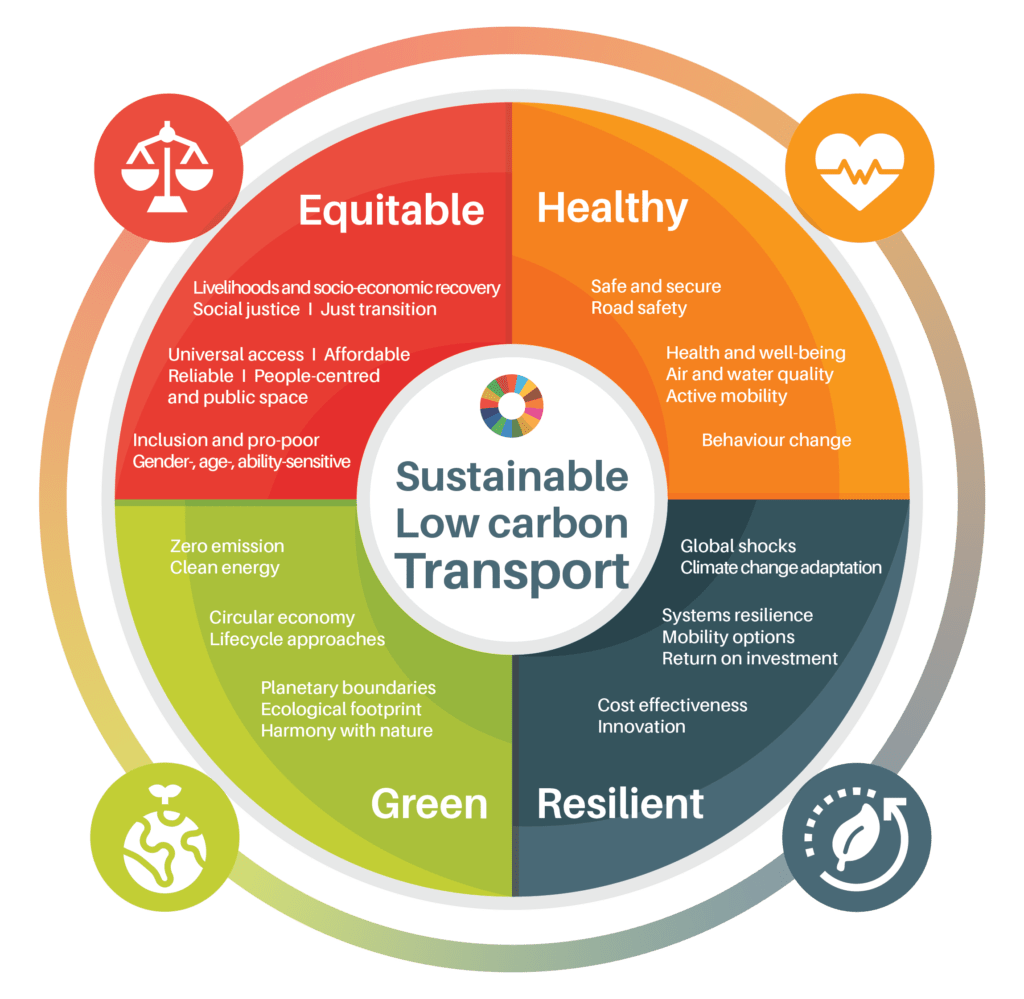
The SLOCAT Wheel on Transport and the SDGs aims to articulate the breadth of positive interactions between sustainable, low carbon transport and mobility and the 2030 Agenda. We have identified four cross-cutting themes — Equitable, Healthy, Green and Resilient — to present these interactions. Under each theme, fundamental notions related to socio-economic and environmental systems on which sustainable, low carbon transport can affect positive change are highlighted.
The 2030 Agenda encourages member states to submit Voluntary National Reviews (VNRs) to the United Nations High-Level Political Forum on Sustainable Development (HLPF), which has been convening annually since 2016 under the auspices of the United Nations Economic and Social Council (ECOSOC). The VNR process aims to facilitate the sharing of experiences among countries, including successes, challenges and lessons learned, with a view to accelerating the implementation of the 2030 Agenda.
In 2021, 43 countries have committed to submitting VNRs and presenting them at the 2021 HLPF. As of 5 July 2021, all submitted VNRs have included references to transport.
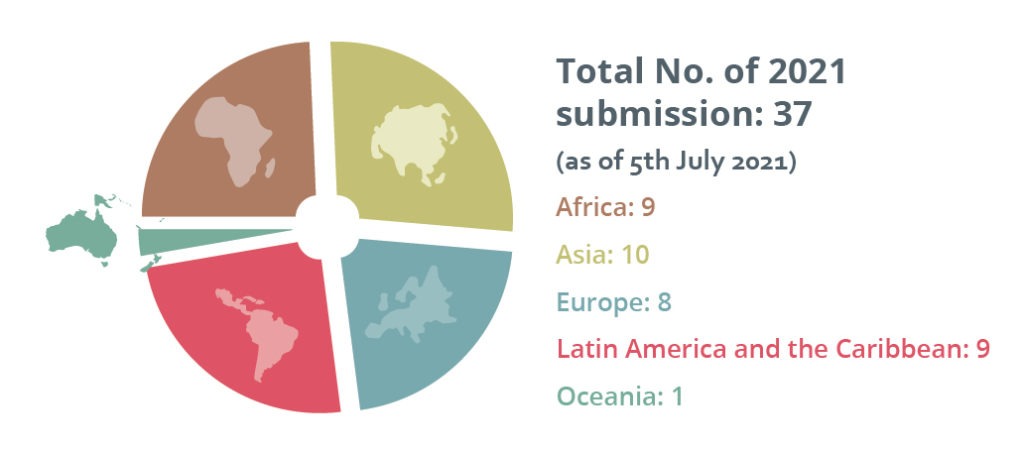
SLOCAT analysis of the VNRs has found a variety of references to sustainable transport policies and measures in support of implementation of the SDGs amidst the global crisis.
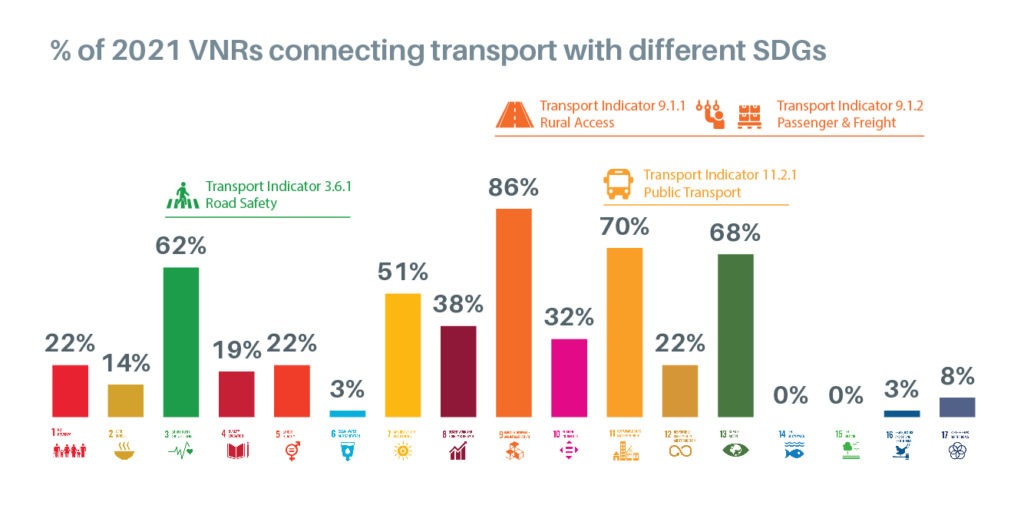
The linkages between transport and the SDGs in VNRs focus on infrastructure, energy, and climate mitigation. However, VNRs would benefit from further attention to the social dimension of sustainable transport, establishing a stronger case for transport’s central role in achieving social equity and Leaving No One Behind.
The global review of progress and barriers towards implementation of the 2030 Agenda occurring at this year’s HLPF, particularly review of SDG 13 – Take urgent action to combat climate change and its impacts, is an important moment to take stock of the major contributors to global greenhouse gas (GHG) emissions, and which actions must be urgently taken to ensure sustainable decarbonisation. In the case of transport, the sector continues to be the fastest growing fossil fuel combustion sector worldwide, with sectoral emissions rising more than 17% between 2010 and 2019.i
Some other concerning trends include:
- The transport sector is 97% fossil fuel-powered and is the least diversified of all energy end-use sectors, remaining far from being fuelled primarily by renewable sources.ii
- Despite progress in reducing the energy intensity of transport, the sector is expected to have the highest carbon intensity among all sectors in 2040 due to its high dependency on fossil fuels.iii
- An analysis of transport emission pathways based on national studies shows that despite recent efficiency gains, the sector is not on track to meet 2050 emission reduction targets. In the most recent (2019) analysis, under the average business-as-usual pathway, global transport CO2 emissions could increase from 8 gigatonnes in 2019 to 14.5 gigatonnes in 2050.iv
- To keep the rise in global temperature below 2 degrees Celsius (°C), annual transport emissions must be reduced to 5 gigatonnes of CO2 or less by 2050; and to keep the rise below 1.5 °C, emissions must be reduced to roughly 3 gigatonnes of CO2 or less. This would mean slashing per capita transport CO2 emissions 75% – from 0.88 tonnes in 2019 to 0.2 tonnes in 2050.v
The COVID-19 pandemic has had a significant impact on carbon dioxide (CO2) emissions from the transport sector, leading to a temporary drop in emissions of 19.4% below 2019 levels.vi This is roughly equal to the reductions needed from the transport sector annually to meet 2050 Paris Agreement targets. However, overall emission trends in the sector point to serious ongoing challenges.
Rising global demand for mobility and goods has had a direct impact on emissions in the transport sector. Transport emission growth is mainly coming from the following:
- Overall growth in the use of road vehicles (both passenger and freight). Road transport is by far the largest driver of transport demand, accounting for 78% of the total in 2017.vii
- A surge in aviation and shipping over the past decade, with both sub-sectors recording double-digit growth in emissions between 2010 and 2019.viii
- Rising preferences for larger personal vehicles. Sport utility vehicles (SUVs) were the second largest source of new CO2 emissions globally between 2010 and 2018, after the power industry.ix
- Dirty and rapidly growing freight transport. In 2017, the freight sector contributed 42% of total transport CO2 emissions as well as disproportionately high levels of local air pollutants.x
- Ride-hailing services, which have increased rather than decreased CO2 emissions in many regions and cities, resulting in an estimated 69% increase in climate pollution compared to the trips they displace, in part by increasing traffic congestion.xi
- Regional emissions growth. Asia experienced the highest increase in transport CO2 emissions among global regions from 2010 to 2019, up 41%, followed by Africa (27%), and Oceania (13%).xii Per capita transport emissions in North America are more than five times the global average due to high rates of car use.xiii
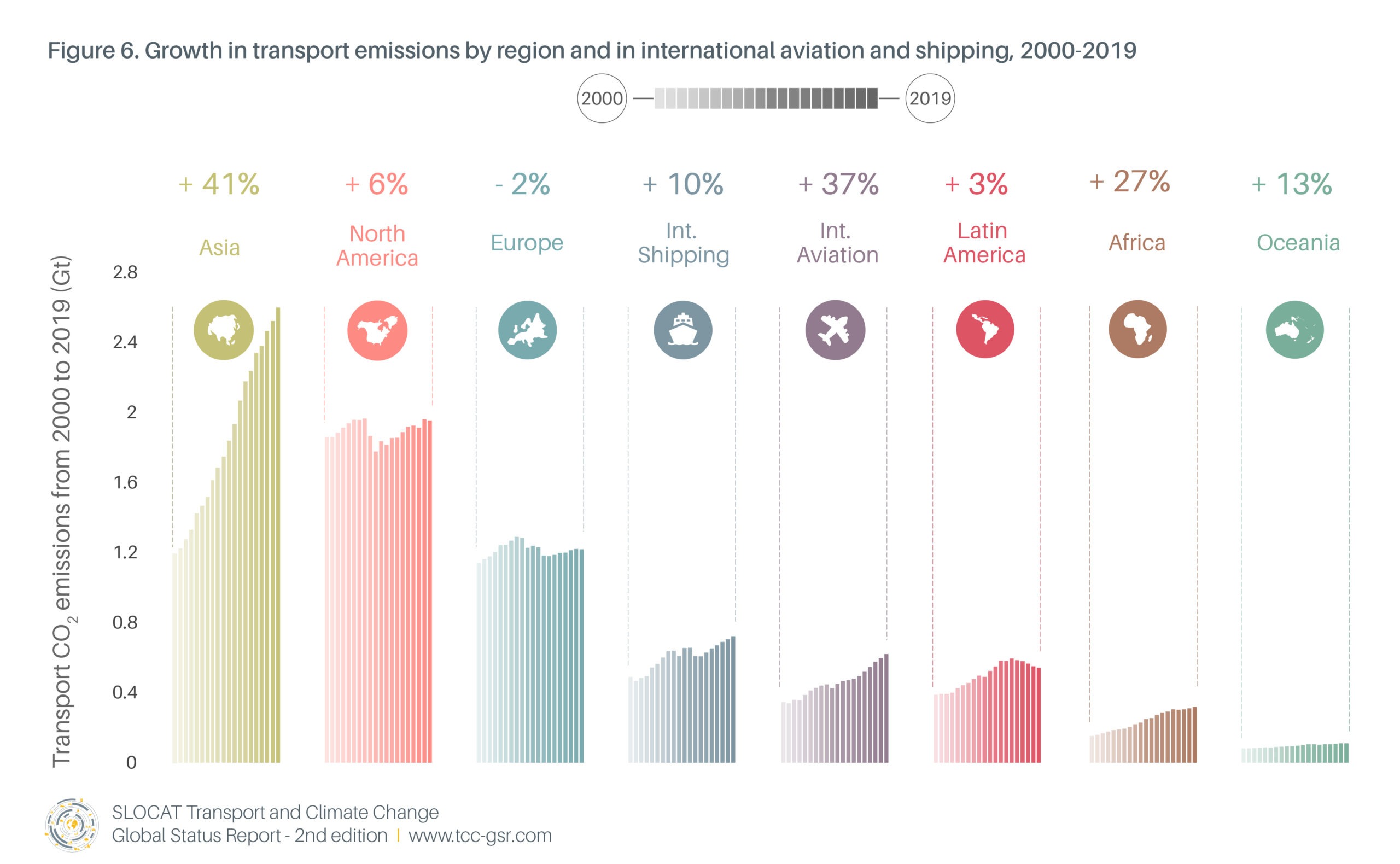
Growth in transport emissions by region and in international aviation and shipping, 2000-2019 from SLOCAT’s Transport and Climate Change Global Status Report – 2nd Edition.
While overall CO2 emissions trends from transport are headed in the wrong direction, several important global trends show signs that this rapid and endless growth in emissions is not inevitable.
- Since 2000, a strong decoupling of GDP and transport CO2 emissions has been observed in OECD countries, with divergence beginning during the 2007 global financial crisis. Non-OECD countries have also experienced a decoupling of transport emissions and GDP growth, although at a lower intensity and a less rapid pace.xiv
- The energy intensity (total energy consumption per unit of GDP) of the transport sector continued to improve in 2018, decreasing 2.1% from the previous year, far faster than the 1.5% average annual decline for 2000-2017.xv
- Global transport emissions increased 1% in 2019, well below the 2% annual average growth rate for the decade.xvi
- Commitments to phase out internal combustion engines are driving more sustainable emission trajectories. Low carbon transport measures are becoming increasingly efficient and leading to more positive trends than were previously projected. Whereas in 2017 the emission gap between the projected business-as-usual and low carbon transport emission levels was estimated to reach 16 gigatonnes of CO2 by 2050, newer estimates (based on studies up to 2019) show a smaller gap of around 12 gigatonnes.xvii
Moving forward, several key areas will be essential for the rapid sustainable decarbonisation of the transport sector:
- More ambitious transport-specific decarbonisation targets. Setting transport-specific emissions reductions targets is essential to catalysing and accelerating action in the sector. Of the 54 second-generation Nationally Determined Contributions (NDCs) of the Paris Agreement submitted from November 2018-May 2021, only 15% include a specific target for reducing transport emissions. Similarly, only a handful of countries have included transport-specific targets in their Voluntary National Reviews (VNRs) of the 2030 Agenda, with only 8 out of 47 countries including them in 2020. Find out more at the Tracker of Climate Strategies for Transport and Analysis of Transport and Voluntary National Reviews.
- Better urban planning and land use. Achieving a 1.5 °C scenario will require a 40% reduction in transport’s final energy consumption.xviii This can be achieved through better urban planning and land use, as a compact city can yield lower transport energy demand, less car dependency, higher passenger density in public transport, and more walking and cycling. Find out more here
- A Shift in focus. How we approach the sustainable development and decarbonisation of the transport sector is important. Traditionally, much of the focus of transport development has been on supply — building infrastructure, including roads, railways, waterways, airways, and terminals to support what has been seen as an-ever growing flow of demand. However, transport demand is in fact a derived demand, meaning that people use transport in order to access other goods or services, not for the sake of using transport itself. This framing demonstrates the need for a comprehensive approach to decarbonisation, which includes land use and location decisions, pricing and other fiscal decisions, and ensuring access to digital services, focusing more resources on the “Avoid” of the Avoid-Shift-Improve
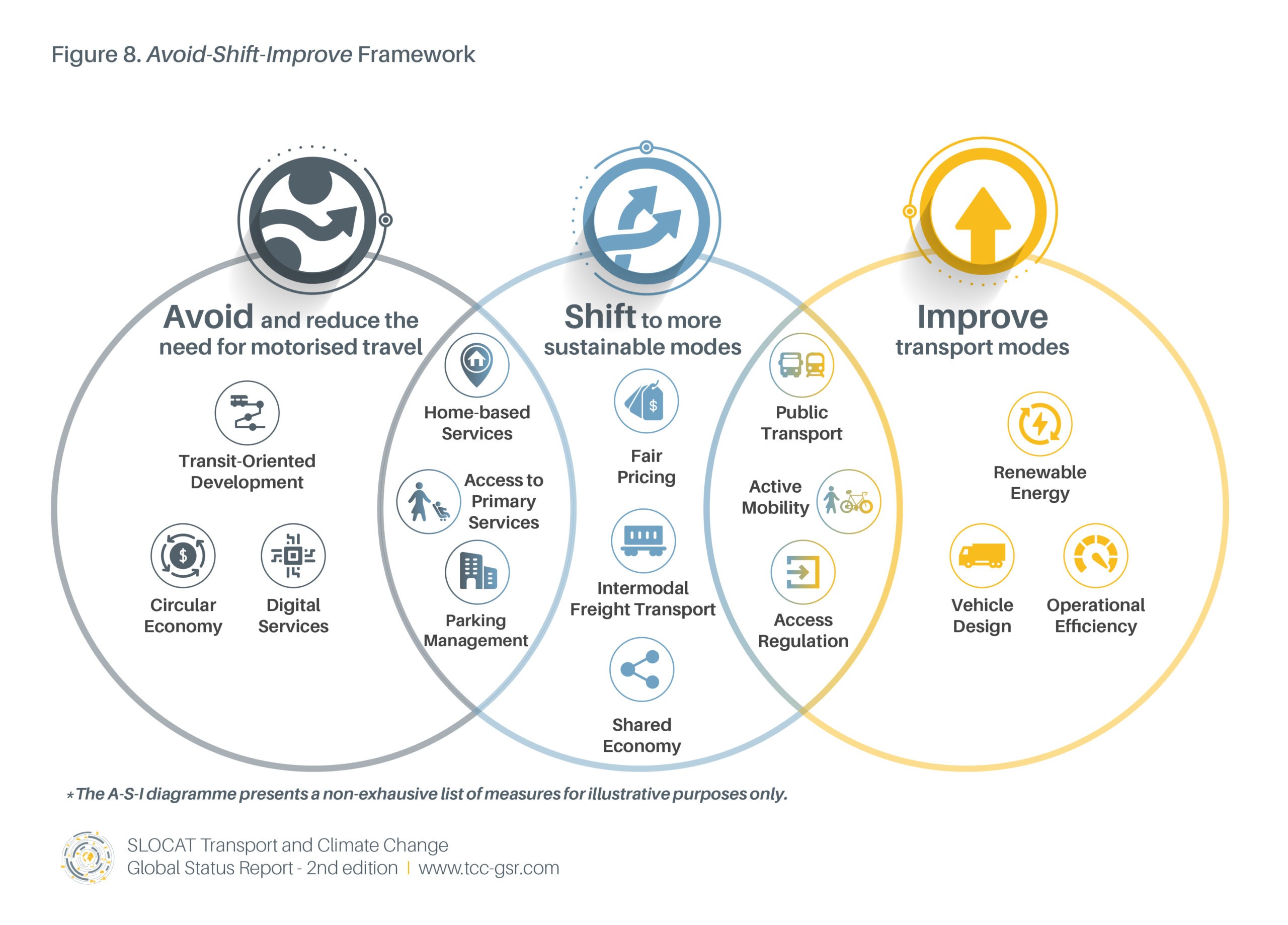
Avoid-Shift-Improve Framework, from SLOCAT’s Transport and Climate Change Global Status Report – 2nd Edition.
- Immediate solutions. Many low-carbon transport measures can be implemented quickly and inexpensively with sufficient political will, demonstrated by the many short-term policy measures that have been implemented during the pandemic, which saw “tactical urbanism” measures – such as the deployment of open streets in more than 194 cities globally as of October 2020 – that allow millions of people to reimagine their daily mobility needs.xix Active transport (walking and cycling) has increased in many cities, with Europe quickly building 1,500 kilometres of bicycle lanes, and allocating EUR 1.7 billion (USD 2 billion) for cycling promotion.xx
- Significant financing. Globally, achieving low carbon transport pathways will require investments of USD 2.7 trillion per year between 2016 and 2030 (or USD 40.5 trillion in total), with 60-70% of these investments in emerging economies.xxi Achieving this level of investment necessitates leveraging private capital as well as support from high-income countries (through direct assistance) and multilateral development banks (through funding frameworks aligned to the Paris Agreement). Find out more here
As the world meets to discuss the current status of global implementation of the 2030 Agenda and its SDGs, it is clear that transport needs to be at the center of these discussions, particularly on progress towards climate action. While the current trajectories are cause for alarm, solutions exist and need to be prioritised to be implemented urgently and at scale.
i M. Crippa et al. (2020), Fossil CO2 Emissions of All World Countries, JRC Science for Policy Report, Publications Office of the European Union, Luxembourg, https://ec.europa.eu/jrc/en/publication/eur-scientific-and-technical-research-reports/fossil-co2-emissions-all-world-countries-2020-report.
ii IEA, “World Balance (2018)”, https://www.iea.org/sankey/#?c=World&s=Balance (accessed 16 May 2021).
iii J. Rogeli et al. (2018), “Chapter 2: Mitigation pathways compatible with 1.5°C in the context of sustainable development”, in Intergovernmental Panel on Climate Change (IPCC) (2018), Global Warming of 1.5°C. An IPCC Special Report on the impacts of global warming of 1.5°C above pre-industrial levels and related global greenhouse gas emission pathways, in the context of strengthening the global response to the threat of climate change, sustainable development, and efforts to eradicate poverty, Geneva, https://www.ipcc.ch/sr15.
iv SLOCAT (2020), TraKB version 0.3, https://slocat.net/tcc-gsr.
v SLOCAT (2020), TraKB version 0.3, https://slocat.net/tcc-gsr.
vi International Energy Agency (IEA) (2021), “Global energy review: CO2 Emissions in 2020”, 2 March, https://www.iea.org/articles/global-energy-review-co2-emissions-in-2020; IEA (2020).
vii IEA (2016), Energy Technology Perspectives 2016, Paris, https://www.iea.org/reports/energy-technology-perspectives-2016; IEA (2019), The Future of Rail, Paris, https://www.iea.org/reports/the-future-of-rail
viii SLOCAT calculations based on M. Crippa et al. (2020), Fossil CO2 Emissions of All World Countries, JRC Science for Policy Report, Publications Office of the European Union, Luxembourg, https://ec.europa.eu/jrc/en/publication/eur-scientific-and-technical-research-reports/fossil-co2-emissions-all-world-countries-2020-report.
ix L. Cozzi and A. Petropoulos (2019), “Growing preferences for SUVs challenges emissions reductions in passenger car market”, IEA, 15 October, https://www.iea.org/commentaries/growing-preference-for-suvs-challenges-emissions-reductions-in-passenger-car-market.
x IEA (2020), Trucks and Buses, Paris, June 2020, https://www.iea.org/reports/trucks-and-buses.
xi E. Bannon (2020), “Uber pollutes more than the cars it replaces – US scientists”, Transport and Environment, 19 March, https://www.transportenvironment.org/news/uber-pollutes-more-cars-it-replaces-us-scientists.
xii SLOCAT calculations based on M. Crippa et al. (2020), Fossil CO2 Emissions of All World Countries, JRC Science for Policy Report, Publications Office of the European Union, Luxembourg, https://ec.europa.eu/jrc/en/publication/eur-scientific-and-technical-research-reports/fossil-co2-emissions-all-world-countries-2020-report.;
xiii Ibid.
xiv World Bank (2020), “GDP (constant 2010 USD),” https://data.worldbank.org/indicator/NY.GDP.MKTP.KD (accessed 28 September 2020; M. Crippa et al. (2020), Fossil CO2 Emissions of All World Countries, JRC Science for Policy Report, Publications Office of the European Union, Luxembourg, https://ec.europa.eu/jrc/en/publication/eur-scientific-and-technical-research-reports/fossil-co2-emissions-all-world-countries-2020-report
xv IEA (2020), Tracking Transport 2020, Paris, https://www.iea.org/reports/tracking-transport-2020
xvi IEA (2020), Tracking Transport 2020, Paris, https://www.iea.org/reports/tracking-transport-2020.
xvii SLOCAT (2020), TraKB version 0.3, https://slocat.net/tcc-gsr.
xviii H. de Coninck et al. (2018), “Chapter 4: Strengthening and implementing the global response”, in IPCC, op. cit. note 1, https://www.ipcc.ch/site/assets/uploads/sites/2/2019/05/SR15_Chapter4_Low_Res.pdf
xix SLOCAT (2021), “SLOCAT quick wins on transport, sustainable development and climate change”, https://slocat.net/quick-wins; T. Combs, “Local actions to support walking and cycling during social distancing dataset”, Pedestrian and Bicycle Information Center, http://pedbikeinfo.org/resources/resources_details.cfm?id=5209 (accessed 29 September 2020).
xx European Cyclists’ Federation (ECF), “COVID-19 Cycling Measures Tracker”, https://ecf.com/dashboard (accessed 20 May 2021).
xxi OECD (2017), Investing in Climate, Investing in Growth, Paris, https://doi.org/10.1787/9789264273528-en.